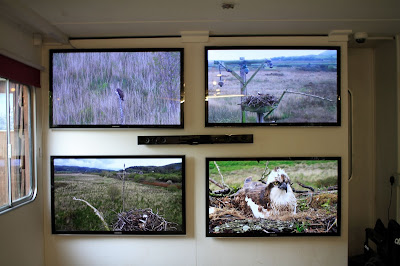The Dyfi Osprey Project is situated within the Cors Dyfi Nature reserve approximately 4 miles from Machynlleth and 18 Miles from Aberystwyth, it is one of the four publicised Osprey Nests in Wales.
The reserve is accessible via public transport, I travelled from Shrewsbury Shropshire by train and caught the X28 Coastliner which conveniently picks up from a stop outside the Station entrance and drops off outside the project. The Dyfi Osprey Project is a request stop so remember to ask the driver. Pick up on the return leg is from the adjacent Morben Isaf Caravan Park which can be accessed form inside the reserve. The A487 is a busy road and the Caravan park is again a request stop as a result you will need to keep a good look out for the return bus.
You will need to rember that the Dyfi Osprey Project is only a part of the Cors Dyfi Nature reserve and there are other hides situated within the reserve. The adult entrance fee is £4.00 and upon entrance you are met with four TV screens that are showing the live feed from the Ospreys nest, the project Staff will also brief you on the reserve and the Ospreys progress.
 |
| TV Monitors Showing the Ospreys on the Nest | | |
|
It's a short walk from the reception to the Osprey viewing platform which is referred to as the 360 Observatory . You will pass two Photography hides and may see a couple of resident Water Buffalo these animals are employed to manage the wildgrasses that are in abundance within the reserve.
 |
| View of the 360 Observatory from the Boardwalk. |
|
Access to the 360 Observatory is via set of steps or a lift they will both ultimately take you to the entrance, it's a very impressive building and is by far the best hide that I have had the good fortune to gain access to.
 |
View of the 360 Observatory
|
The Ospreys Nest is situated some 200 Meters away from the Observatory which is quite a distance again there is a TV in the Observatory which shows the live feed from the nest. There are a series of Windows in the Observatory which can be opened to allow Photography, the best position is to the left and right of the two main windows, the main windows have dedicated birdscopes that can be viewed through.
 |
| Spotting Scope showing the side windows |
To obtain a reasonable image of the Ospreys sitting on the nest you'd need at least a 300 Mil Lens plus a x Convertor, however you can get lucky as I'm told that the Ospreys do fly close and past the Observatory especially when the chicks have hatched .
 |
| Ospreys on the Nest as viewed from the Observatory |
|
|
Both of the Ospreys take turns in incubating the eggs but there is not a lot of activity on a daily basis that is before the chicks are hatched, the Male Osprey will go fishing at least once a day and he will give the fish to the female to eat. The birds will swap positions and fly between perches and there is also a low perch that the male favours, unfortunately this out of sight of the Observatory but can be seen on the Camera feeds.
 |
| Osprey Facts viewed through an Observatory side window, note the trees . |
In conclusion if you've not seen an Osprey in the UK before then this reserve is worth a visit as you can glean quite a lot of information about the UK migratory Osprey population, and it does offer the Photographer the best chance of getting a half decent image of an Osprey in flight. There are other locations outside the reserve where there may be a greater chance of Photographing an Osprey
in flight, if you speak to the Volunteers they will point these out to you.
 |
| Image of an Osprey on the Nest viewed from inside the 360 Observatory. |
|
Osprey Facts: Length 22ins. Female 24ins. Bird of Passage April , September Nests (end of April) in trees on islets in Lochs. Male brings materials and helps incubate 2-3 eggs, 1 brood. Both parents feed young. Young hatched with open eyes.










Comments
Post a Comment
Appreciate your feedback good or Bad